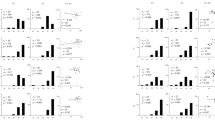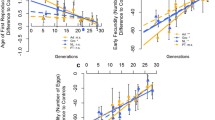Abstract
Daphnia magna clones, isolated from different natural populations, were inbred and crossbred. Some aspects of the heredity of the phototactic behaviour, quantified by an index, were analysed. Heritability in the broad sense was determined for several assemblages of clones through calculation of the clonal repeatability. Heritability sensu strictu was determined by offspring-parent regressions. Frequency distributions of a phototactic index of several inbred and crossbred families are given.
The results indicate a significant contribution of additive genetic variance to the total phenotypic variance. Comparison of heritability estimates suggests an important genetic interaction component.
Some implications of these results on the variability of vertical migration patterns in natural populations are discussed.
Similar content being viewed by others
References
Arthur, W., 1984. Mechanisms of morphological evolution, a combined genetic, developmental and ecological approach. J. Wiley & Sons, Chichester, 275 pp.
Banta, A. M., 1939. Studies on the physiology, genetics, and evolution of some Cladocera. Publ. Carnegie Inst. 513: 285 pp.
Benzer, S., 1967. Behavioral mutants of Drosophila isolated by countercurrent distribution. Proc. natn. Acad. Sci. U.S.A. 58: 1112–1119.
Brookfield, J. F. Y., 1981. No evidence for frequency-dependent selection acting between clones of the water flea, Daphnia magna. Heredity 47: 297–315.
Bunner, H. C. & K. Halcrow, 1977. Experimental induction of the production of ephippia in Daphnia magna Straus (Cladocera). Crustaceana 32: 77–86.
Butlin, R. K. & G. M. Hewitt, 1986. Heritability estimates for characters under sexual selection in the grasshopper, Chorthippus brunneus. Anim. Behav. 34: 1256–1261.
Carvalho, G. R. & R. N. Hughes, 1983. The effect of food availability, female culture-density and photoperiod on ephippia production in Daphnia magna Straus (Crustacea: Cladocera). Freshwat. Biol. 13: 37–46.
Chapman, A. R. O., 1974. The genetic basis of morphological differentiation in some Laminaria populations. Mar. Biol. 24: 85–91.
Davison, J., 1969. Activation of the ephippal eggs of Daphnia pulex. J. gen. Physiol. 53: 565–575.
De Meester, L., 1989. An estimation of the heritability of phototaxis in Daphnia magna Straus. Oecologia 78: 142–144.
De Meester, L., in press. Evidence for intrapopulation genetic variability for phototactic behaviour in Daphnia magna Straus, 1820. Biol. Jb. 58.
De Meester, L. & H. J. Dumont, 1988. The genetics of phototaxis in Daphnia magna: Existence of three phenotypes for vertical migration among parthenogenetic females. Hydrobiologia 162: 47–55.
De Meester, L. & H. J. Dumont, 1989. Phototaxis in Daphnia: interaction of hunger and genotype. Limnol. Oceanogr. 34: 1322–1325.
Dumont, H. J., Y. Guisez, I. Carels & H. M. Verheye, 1985. Experimental isolation of positively and negatively phototactic phenotypes from a natural population of Daphnia magna Straus: A contribution to the genetics of vertical migration. Hydrobiologia 126: 121–127.
Falconer, 1981. Introduction to quantitative genetics, second edition. Longman, New York, 340 pp.
Gerritsen, J., 1980. Sex and parthenogenesis in sparse populations. Am. Nat. 115: 718–742.
Harris, J. E., 1963. The role of endogenous rhythms in vertical migration. J. mar. biol. Ass. U.K. 43: 153–166.
Hebert, P. D. N., 1978. The population biology of Daphnia (Crustacea, Daphniidae). Biol. Rev. 53: 387–426.
Hebert, P. D. N., 1981. Obligate asexuality in Daphnia. Am. Nat. 117: 784–789.
Hebert, P. D. N., 1984. Demographic implications of genetic variation in zooplankton populations. In: Wöhrmann, K. & V. Loeschcke, Population Biology and Evolution. Springer-Verlag, Berlin: 195–207.
Hebert, P. D. N., 1987a. Genotypic characteristics of the Cladocera. Hydrobiologia 145: 183–193.
Hebert, P. D. N., 1987b. Genetics of Daphnia. In: Peters, R. H. & R. de Bernardi (eds.), Daphnia, Mem. Ist. ital. Idrobiol. 45: 143–192.
Hebert, P. D. N. & R. D. Ward, 1972. Inheritance during parthenogenesis in Daphnia magna. Genetics 71: 639–642.
Korpelainen, H., 1986. The effects of temperature and photoperiod on life-history parameters in Daphnia magna (Crustacea: Cladocera). Freshwat. Biol. 16: 615–620.
Lynch. M., 1983. Ecological genetics of Daphnia pulex. Evolution 37: 358–374.
Mather, K. & J. L. Jinks, 1981. Biometrical genetics, third edition. Chapman and Hall, London.
Parsons, P. A., 1973. Behavioural and ecological genetics, a study in Drosophila. Clarendon Press, Oxford.
Richmond, R. C., 1969. Heritability of phototactic and geotactic responses in Drosophila pseudoobscura. Am. Nat. 103: 315–316. geotactic responses in Drosophila pseudoobscura. Am. Nat. 103: 315–316.
Ringelberg, J. & H. Servaas, 1971. A circadian rhythm in Daphnia magna. Oecologia 6: 289–292.
Rockwell, R. F. & M. B. Seiger, 1973. Phototaxis in Drosophila: A critical evaluation. Am. Sci. 61: 339–345.
Schwartz, S. S. & P. D. N. Hebert, 1987. Methods for the activation of the resting eggs of Daphnia. Freshwat. Biol. 17: 373–379.
Sokal, R. R. & F. J. Rohlf, 1981. Biometry, second edition. Freeman, San Francisco.
Sprague, G. F., 1955. Problems in the estimation and utilization of genetic variability. In: Population genetics: the nature and causes of genetic variability in populations. Cold Spring Harbor Symp. quant. Biol. 20: 87–92.
Stross, R. G., 1966. Light and temperature requirements for diapause development and release in Daphnia. Ecology 47: 368–374.
Stross, R. G., 1969. Photoperiod control of diapause in Daphnia. III. Two-stimulus control of long-day, short-day induction. Biol. Bull. 137: 359–374.
Stross, R. G., 1987. Photoperiodism and phased growth in Daphnia populations: coactions in perspective. In: Peters, R. H. & R. de Bernardi (eds.), Daphnia, Mem. Ist. ital. Idrobiol. 45: 413–437.
Thoday, J. M. & J. N. Thompson Jr., 1976. The number of segregating genes implied by continuous variation. Genetics 46: 335–344.
Weider, L. J., 1984. Spatial heterogeneity of Daphnia genotypes: Vertical migration and habitat partitioning. Limnol. Oceanogr. 29: 225–235.
Weider, L. J., 1985. Spatial and temporal genetic heterogeneity in a natural Daphnia population. J. Plankton Res. 7: 101–123.
Young, J. P. W., 1979. Enzyme polymorphism and cyclic parthenogenesis in Daphnia magna. II. Heterosis following sexual reproduction. Genetics 92: 971–982.
Zaffagnini, F., 1987. Reproduction in Daphnia. In: Peters, R. H. & R. de Bernardi (eds.), Daphnia, Mem. Ist. ital. Idrobiol. 45: 245–284. 229–243.
Author information
Authors and Affiliations
Rights and permissions
About this article
Cite this article
De Meester, L. An analysis of the phototactic behaviour of Daphnia magna clones and their sexual descendants. Hydrobiologia 225, 217–227 (1991). https://doi.org/10.1007/BF00028400
Issue Date:
DOI: https://doi.org/10.1007/BF00028400




